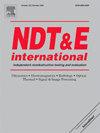Optimization of selection matrix capture for micro defects laser ultrasound imaging using multi-parameter genetic algorithm
IF 4.1
2区 材料科学
Q1 MATERIALS SCIENCE, CHARACTERIZATION & TESTING
引用次数: 0
Abstract
Ultrasonic testing plays a crucial role in detecting early structural damage and identifying micro-defects, particularly in processes like additive manufacturing and welding. The full matrix capture (FMC) method, leveraging laser ultrasound technology, excels in imaging sub-millimeter micro defects. However, its extensive data acquisition time hinders real-time imaging. To address this, a selection matrix capture approach is adopted to reduce data collection and enhance detection speed. Specifically, a multi-parameter genetic algorithm (MPGA) is proposed to optimize sparse array layouts. This optimization is based on theoretical detection sensitivity means and standard deviations, evaluating array layout quality. The imaging method combined multi-scale principal component analysis with phase weighting techniques. Experiments on sub-millimeter defects, including side drilling holes (SDH), blind holes (BH), and spherical holes (SH), were conducted. Results showed that, compared to random and uniform sparsity, the genetic algorithm optimized sparse array provided superior imaging as sparsity decreased. Effective defect detection was achieved with only 5 %–20 % of full matrix data.
求助全文
约1分钟内获得全文
求助全文
来源期刊

Ndt & E International
工程技术-材料科学:表征与测试
CiteScore
7.20
自引率
9.50%
发文量
121
审稿时长
55 days
期刊介绍:
NDT&E international publishes peer-reviewed results of original research and development in all categories of the fields of nondestructive testing and evaluation including ultrasonics, electromagnetics, radiography, optical and thermal methods. In addition to traditional NDE topics, the emerging technology area of inspection of civil structures and materials is also emphasized. The journal publishes original papers on research and development of new inspection techniques and methods, as well as on novel and innovative applications of established methods. Papers on NDE sensors and their applications both for inspection and process control, as well as papers describing novel NDE systems for structural health monitoring and their performance in industrial settings are also considered. Other regular features include international news, new equipment and a calendar of forthcoming worldwide meetings. This journal is listed in Current Contents.
 求助内容:
求助内容: 应助结果提醒方式:
应助结果提醒方式:


